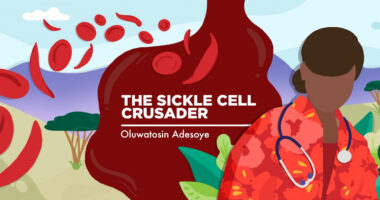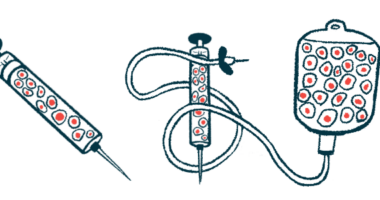Forgive me if I don’t share the enthusiasm about a sickle cell cure
Recent headlines in the U.K. lauded the approval of a gene-editing therapy

The date was Friday, Jan. 31, 2025. It started like any other day. As I settled down to start working, I noticed I had a lot of messages, and more came in as the day went on. Message after message, phone call after phone call alerted me about a supposed new cure for sickle cell disease.
My initial reaction was to ignore the calls and messages until I was in the right headspace. People don’t mean any ill will when they share news like this with sickle cell patients like me. If I don’t happen to share their enthusiasm, they probably wouldn’t understand why. These things can upset me, and I never want to express negative emotions to people who don’t deserve it.
A few weeks have passed since then, and now that I’ve had time to calm down, I wanted to explain why some of us sickle cell patients didn’t react to the news the way that some people had expected.
Some context on sickle cell cures
There is a common misconception that there is no cure for sickle cell disease. However, this isn’t entirely true. A stem cell transplant, when successful, can cure sickle cell disease, as a resource page here at Sickle Cell Disease News points out. “However, the procedure carries substantial risks for severe complications. Therefore, the procedure is generally only recommended for [sickle cell] patients in specific situations,” it notes.
Bone marrow stem cells are responsible for red blood cell production. A transplant takes healthy stem cells harvested from a donor and replaces the patient’s stem cells. The hope is that the patient’s body won’t reject the donor’s stem cells, and nonsickle stem cells will produce nonsickle red blood cells, hence curing the patient.
With all of that said, new cures are indeed needed and would be a wonderful thing.
But think about this from a patient’s perspective: You’re living with a debilitating condition that you inherited at birth, and there actually is a cure. It’s risky, yes, but it does exist. However, you can’t access it due to its high cost or other restrictive requirements. Imagine the effect this has on a patient. You’re living with this condition every day, knowing that there’s a possible cure, but you can’t access it because you’re either not a millionaire or you’re not considered “sick enough” to warrant receiving transplant in the eyes of the National Health Service (NHS) here in the U.K.
For context, in 2018 and 2019, I spent over 400 days in the hospital, yet I wasn’t considered “sick enough” for curative stem cell transplant. That demonstrates the extremely high threshold for sickle patients to meet to be eligible for the procedure in the U.K. That’s why some of us are skeptical anytime we hear about a potential new cure.
Beyond the headlines
Enter exagamglogene autotemcel, a one-off gene-editing therapy that prompted the flurry of emails and phone calls on that day in January. A headline from a Jan. 31 post on NHS England’s website announces that a “Revolutionary gene-editing therapy for sickle cell ‘offers hope of a cure’ for NHS patients.” The story says that the National Institute for Health and Care Excellence had approved exagamglogene autotemcel for older children and adults with a severe form of sickle cell disease.
NHS Chief Executive Amanda Pritchard stated that, “This innovative, gene-editing therapy offers hope of a cure for people facing a severe form of the disease and could be absolutely transformative — it could enable patients to live free from the fear of sickle cell crises hanging over them.”
The therapy works by using a gene-editing technology called CRISPR/Cas9 to ultimately prevent red blood cell sickling. To do so, a patient’s hematopoietic stem cells are collected and edited in a lab. Then they’re returned to a patient via stem cell transplant.
Headlines heralded this new curative therapy as groundbreaking and life-changing. But I didn’t see many sickle cell patients quoted in the stories. Maybe that’s due to the skepticism over the issue that I’ve observed in the sickle cell patient community.
If you read beyond the headlines, you’ll notice that this therapy will be made available in the U.K. only to “eligible patients who are 12 years and older who experience recurrent sickle cell crises and would be suitable for a stem cell transplant but where a donor is not available,” the NHS stated. That’s only about 50 patients a year — out of approximately 15,000 people living with sickle cell disease in England.
Don’t get me wrong: This is fabulous news for those 50 patients each year, and I am ecstatic for them. But this is only a small fraction of the total sickle cell population here.
Hopefully, you’ll understand now why the announcement about exagamglogene autotemcel wasn’t a huge deal for many of us in the sickle cell community here in the U.K. For me, being skeptical is a defense mechanism to protect myself from the emotional harm of believing a cure might be available to me and others when it’s actually not.
Note: Sickle Cell Disease News is strictly a news and information website about the disease. It does not provide medical advice, diagnosis, or treatment. This content is not intended to be a substitute for professional medical advice, diagnosis, or treatment. Always seek the advice of your physician or other qualified health provider with any questions you may have regarding a medical condition. Never disregard professional medical advice or delay in seeking it because of something you have read on this website. The opinions expressed in this column are not those of Sickle Cell Disease News or its parent company, Bionews, and are intended to spark discussion about issues pertaining to sickle cell disease.








Edna
My adult son is struggling with SS.We need help.
Carl
You might not be enthusiastic but look at the accomplishments of 33 years of non-stop work San Rocco Therapeutics. Advancing Accessible Gene Therapy for Sickle Cell Disease--San Rocco Therapeutics Gets Closer https://www.trialsitenews.com/a/advancing-accessible-gene-therapy-for-sickle-cell-disease-san-rocco-therapeutics-gets-closer-242a8ff5
San Rocco Therapeutics has been rated safer and much more affordable than all competitors to cure Sickle Cell Disease and Thalassemia.
Rosalía
Thanks for searing I totally get you in all your reflections
Tolani
Hi,
I thought Cas9 requires no donor. It just edits the fetal hemoglobin production of the patient. In essence the patient is the donor. This I think is fantastic as it prevents the host to graft concern from external donors.
Jason Robert Moore
I speak on the other forgotten issue here in the US, after the cure what about the chronic issues that Sickle Cell has dealt? Beautiful for no more crises, but I still have avascular necrosis & organ damage from 40 years of living. Remember, for the Warriors we've lost because of it, we go from "complications" from Sickle Cell. Grand for those without the wear & tear.
For those of us who have been through the storm, stripping us of our immune system is typically what takes us out while healing in the hospital from some random infection. I just was on a call about a new treatment & heard this step would no longer be needed but still nothing for the chronic issues. I know perfection isn't capable, I just don't want to keep losing Warriors because of hope
Roy Hutchinson
Thank you for your article, I think 2025 will bring more awareness to the disease and a major push to develop a genetic editing approach so that endogenous stem cells can be used. Moreover, free screening to reduce new SCD births. If we can get free in vitro fertilization and gene editing, we can begin an eradication program. The new administration already has free in vitro fertilization on the agenda.
Esmie Dunbar
Mary Shaniqua hi I am a mother living in the United States who lost my daughter in the hands of evil Dr my daughter where taking disadvantage of at just 18 years old went in for pain the first time in the ER with her sister no meds no oxygen they gave her Norcan she was by her self for a short time gave her 8 bags of blood transfusions in 2 hours no CPR she gain 29 lbs in 2 hours she was dead .I am bringing awareness of my story and I am elated of the gene therapy in American and hope black peoples educate themselves about the knowledge. Continue bringing awareness.
Robs Dad
My son has sickle cell and I understand where you are coming from. I realize a lot of people have never heard of sickle cell disease. Some say, "he will get better" or "it will go away" not knowing its a lifetime thing.
People sending sickle cell cures is most common when you first tell someone about sickle cell. They'll research it or hear about it in the news and then send you links to articles about stuff still in the early stages as if we'd be able to just go and get the procedure done like its just a nose job or something. They don't even fully research what they are sending you and are shocked when you mention they need chemo or a perfect match and whatnot. Beyond that you have to be eligible based on a bunch of things (which is normal) and its crazy expensive.
People treat it like a meme where they see something even mention sickle cell and they send it to me like it doesn't bring back the pain of first finding out your son will have this disease they cannot cure easily. I might not have sickle cell myself but seeing my boy tied to tubes and IV's before he could even speak is a special kind of pain I hate having to re-live just cause someone heard about something on the news.